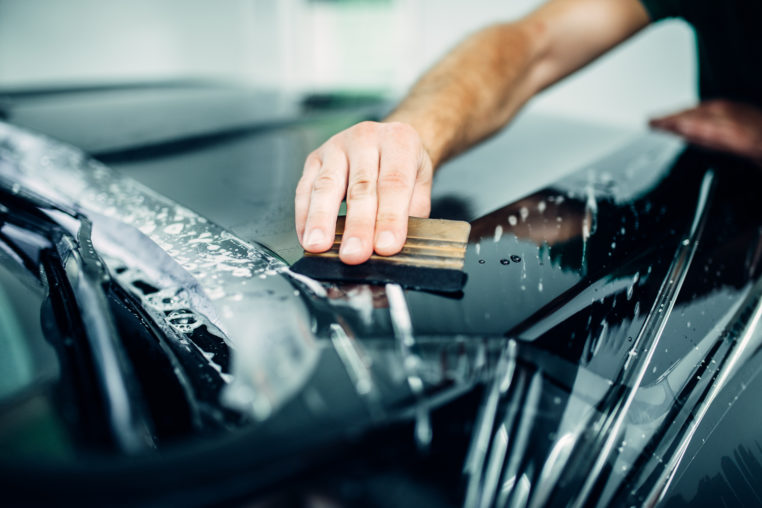
5 Myths About XPEL Paint Protection Film Debunked
Like most drivers, you likely take pride in keeping your car looking pristine. However, as car owners are all too aware, a car’s paint job won’t stay looking shiny and new forever. Debris on the road can cause chips and scratches in your paint, and the sun’s harsh UV rays can cause it to fade and oxidize over time, giving your car an aged and weathered look. Fortunately, this can be prevented by adding a paint protection film (PPF) to your car’s exterior. This clear film is installed on top of a car’s paint job to protect it from the hazards of the road, keeping it looking like new for years to come. However, while paint protection films have been on the market for decades, and advancements in technology mean that they provide better protection than ever before, there are still countless myths about these products that continue to spread. To help you make an informed decision about whether a PPF is right for your car, here is a look at the top 5 myths about XPEL paint protection films.
Myth #1: PPF Turns Yellow Over Time
This is an outdated myth about paint protection films that has been hard to shake. While it is true that early PPFs were made of PVC, and they would often turn yellow or even crack with prolonged exposure to sunlight, this is no longer the case with most modern films. With advancements in technology, today’s urethane films are much more durable and can protect your car for years without showing any signs of damage. While this may not be the case with every PPF, and some manufacturers use cheap materials, XPEL is so confident is the quality of their paint protection films that they offer a 10 years warranty on these products. When purchasing an XPEL paint protection film, you can feel secure in the quality and longevity of the finished product, and you will not have to worry about the film becoming discolored.
Myth #2: Paint Protection Film Will Damage My Paint Job
One of the most common myths surrounding paint protection films is that the adhesive used to attach it causes damage to a car’s paint job, and you are not alone if this is the primary reason you have been hesitant to have one added to your car. Fortunately, this could not be further from the truth. Paint protection films are designed to protect your car’s paint from oxidation, scratching, and other forms of damage. It would then be counterintuitive to use adhesives that could potentially cause damage to a car’s paint job over time.
The truth is that paint protection films are not only safe for your car, but in the long run they will help to protect your car from damage. Many PPFs even have self-healing characteristics, allowing scratches to the film to “heal” and prevent further damage. Paint protection films can even be removed easily without harming your paint should you choose to do so, but it is critical that you have this done by a professional. Should you attempt to remove a PPF from your car yourself, you could end up damaging your paint and leaving behind glue residue. However, when a PPF is removed professionally, the paint below will look as pristine as the day the film was installed.
Myth #3: PPF Will Devalue My Car
For one reason or another, people worry that applying a paint protection film to their car will decrease the vehicle’s value and make it more difficult to sell down-the-road. The truth is that a high-quality PPF from XPEL can actually help you to protect your investment by keeping the exterior of your car in pristine shape. Since scratched, chipped, and faded paint can be turnoffs to buyers, a paint protection film will ensure that your car maintains its look and potential resale value over the years. Additionally, while a paint protection film might be a selling point for some buyers, these films can be easily removed if necessary when you go to sell your car.
Myth #4: PPFs Always Peel Up At The Edges
One of the biggest fears car owners have about paint protection films is that they will begin to peel at the edges after installation, making them look tacky. While this can happen when someone installs a PPF who doesn’t know what they are doing, the goal of a professional installer is to make a paint protection film look as seamless as possible. In fact, a properly installed PPF will likely be unnoticeable to the untrained eye. Of course, it is important to remember that PPF’s are not completely invisible, as you are adding a fairly thick layer of protection film to your car’s exterior. However, a good installer will make a PPF nearly unnoticeable, and you will likely only see the edges and seams if you go looking for them. This is why it is important that you have your PPF professionally installed rather than attempt to do it yourself, as a professional installer will make sure that your car looks polished and pristine.
Myth #5: All Paint Protection Films Are The Same
Many car owners believe that all PPFs are the same, and they will go with the installer/manufacturer who is currently offering the best deal. However, as with any type of product, there is a reason some paint protective films are so much cheaper than others, and just because one is a good deal up front does not mean that it will provide long-term value. The last thing you want to do is invest in a paint protection film only for it to start peeling and cracking in a few weeks. You may also find that a cheap film does not protect your car against scratches. In order to ensure that your car is properly protected, you should consider investing in an XPEL paint protection film.
The fact is that there is a reason XPEL is able to provide a warranty on their paint protection films that is unmatched in the industry. This is because they have taken the time to research and invest in ground-breaking technology, and one of their top-of-the-line films will ensure that your car is protected from the elements, and hazards on the road, for years to come.
Feel free to contact us to learn more about what sets XPEL’s paint protection films apart and the benefits that adding a PPF to your car could provide you with.
- 5 Myths About XPEL Paint Protection Film Debunked - December 1, 2021
- Ceramic Coatings vs Paint Protection Films - October 18, 2021
- How to Make Your Car’s Ceramic Coating Last Longer - September 23, 2021



